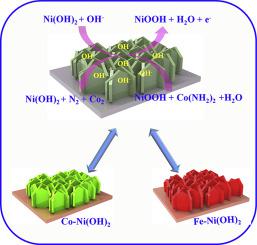International Journal of Hydrogen Energy ( IF 8.1 ) Pub Date : 2021-08-25 , DOI: 10.1016/j.ijhydene.2021.08.022 Hui Wang 1, 2 , Lei Lu 1 , Palaniappan Subramanian 3 , Shan Ji 1 , Palanisamy Kannan 1

|
Developing a highly active, low-cost, and durable nanostructured catalytic material is of significant interest in fuel cell applications owing to its efficient energy conversion, ease of preparation and operation, and reduced emission of pollutants. In this work, various ratio (0.01, 0.03, and 0.05 mmol) of cobalt (Co), and iron (Fe) doped nickel hydroxide (Ni(OH)2) nanosheet arrays were grown on Ni foam surface (Co–Ni(OH)2 and Fe–Ni(OH)2) via a simple one-step process. The Co–Ni(OH)2 and Fe–Ni(OH)2 nanosheet array on Ni foam electrodes were explored as potential candidate towards electro-oxidation of urea. Notably, 0.03 mmol Co doped Ni(OH)2/Ni foam electrode displayed lowest-onset oxidation potential (0.21 V) and enhanced electro-oxidation of urea (59.7 mA) owing to its large amount of electrocatalytic active sites, densely assembled nanosheet array structures with porous surfaces, and electronic diffusion channels, which might promote interface electrochemical reaction. In addition, synergistic effect between Co metal with Ni(OH)2 has also promotes enhanced electro-oxidation of urea in contrast to Fe–Ni(OH)2 nanosheet array, Ni(OH)2, and Ni foam electrodes. Chronoamperometric i-t curve of Co–Ni(OH)2/Ni foam electrode obviously exhibited higher catalytic current, highly stable and durable properties in contrast to Fe–Ni(OH)2 nanosheet arrays. As-fabricated Co–Ni(OH)2/Ni foam can be explored as a new type of potential low-cost catalyst for electro-oxidation of urea, which reveals promising use in future fuel cell energy applications.
中文翻译:

Co、Fe离子嵌入Ni(OH)2网络状纳米片阵列作为尿素电氧化的高效非贵金属催化剂
由于其高效的能量转换、易于制备和操作以及减少污染物的排放,开发高活性、低成本和耐用的纳米结构催化材料在燃料电池应用中具有重要意义。在这项工作中,钴的各种比例(0.01,0.03,和0.05毫摩尔)(Co)和铁(Fe)的氢氧化掺杂镍(Ni(OH)2)纳米片阵列上生长镍泡沫表面(钴-镍(OH ) 2和 Fe-Ni(OH) 2 ) 通过一个简单的一步过程。探索了泡沫镍电极上的 Co-Ni(OH) 2和 Fe-Ni(OH) 2纳米片阵列作为尿素电氧化的潜在候选物。值得注意的是,0.03 mmol Co 掺杂的 Ni(OH) 2/Ni泡沫电极由于其大量的电催化活性位点、具有多孔表面的密集组装的纳米片阵列结构和电子扩散通道,显示出最低的起始氧化电位(0.21 V)和增强的尿素电氧化(59.7 mA)。可能促进界面电化学反应。此外,与 Fe-Ni(OH) 2纳米片阵列、Ni(OH) 2和泡沫镍电极相比,Co 金属与 Ni(OH) 2之间的协同作用也促进了尿素的电氧化增强。计时它钴-镍的曲线(OH)2 /镍泡沫电极明显表现出更高的催化电流,在对比的Fe-Ni(OH)高度稳定和耐久的特性2纳米片阵列。制备的 Co-Ni(OH) 2 /Ni 泡沫可作为一种新型潜在的低成本尿素电氧化催化剂,这在未来的燃料电池能源应用中具有广阔的应用前景。











































 京公网安备 11010802027423号
京公网安备 11010802027423号